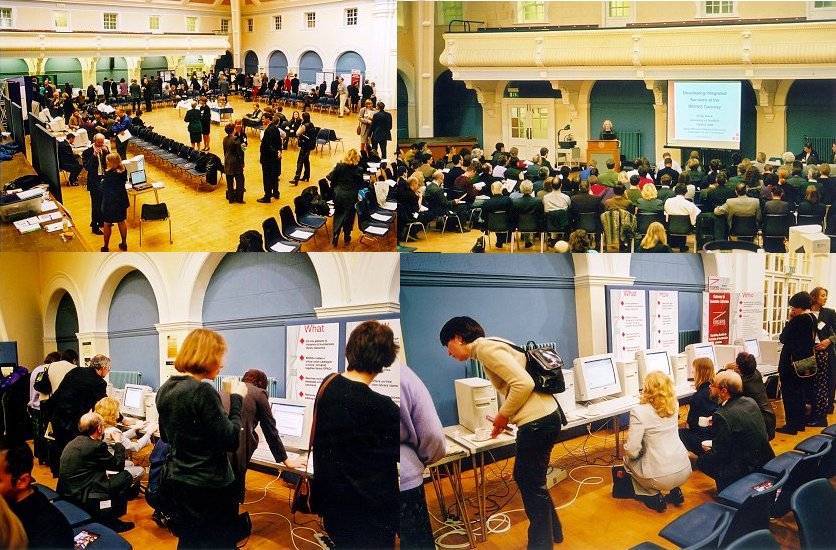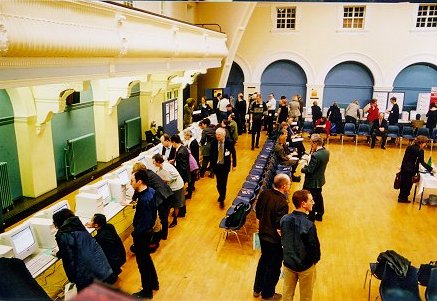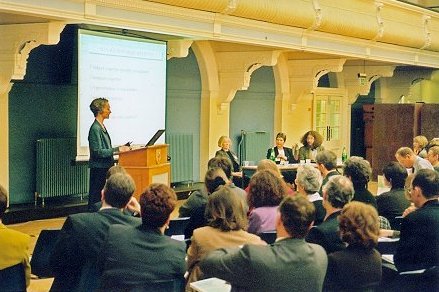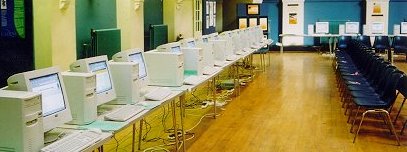Catalogues for the 21st Century
Last year’s CLUMPS meeting took place in a large purpose built lecture theatre in the new British Library building at St Pancras. This was very handy for those of us arriving from Bath, since it is only 3 tube stops or so from Paddington to St Pancras/Kings Cross. This year the meeting is split into two events, and the first of these was arranged to happen at Goldsmiths College at New Cross in South East London. This is way out east for those coming from way out west (though amazingly still in zone 2). Not the most glamorous part of London: all the ground-level panes of glass in the frontage of New Cross tube station were shatter stressed and/or smashed through, and held in place by a layer of polythene, apparently as a a semi-permanent arrangement. Those who travelled to the event by the Jubilee line and its extension had the thrill of an uncharacteristically smooth journey on the last leg before changing to a train at Canada Water, and experience of the Godard ‘Alphaville’ type tube stations with their suicide proof (and probably shatter proof) glass platform-edge walls and gates. The oddest thing was the absence of posters and advertising.
The weather was very good: there were clear blue skies for most of the day. The college assembly hall used at Goldsmiths is large and airy: it admits large amounts of natural light through ceiling windows, and the effect can be seen in the accompanying photographs of the event. There were some problems during the day with poorish sound (accoustically I would guess that the hall functions better at right angles to the arrangement of speakers and audience used), but the hands-on facilities made available by Goldsmiths were first-class, with around a couple of dozen networked machines ranged around two edge walls.
Unfortunately Ariadne arrived in New Cross a little later than expected, and so missed the welcome address by Chris Batt. A number of remarks he made however resurfaced later in the course of the day: one of these was (apparently) a concern that he didn’t know precisely what a CLUMP was. This is of course a major problem in the selling of the idea to those who may benefit from the wider implementation of CLUMPs type systems. Ariadne too is sometimes perplexed about what is going on, and particularly by the precise implications of the terminology used by projects. And at one point in the proceedings was bemused by the unexpected yoking of the ‘meta’ prefix with the term ‘clump’. As in ‘meta-clump’ (of which more later).

CAIRNS Project
Helena Gillis spoke on behalf of the CAIRNS project, which is a Scottish clump. CAIRNS has successfully implemented a working gateway for cross-searching sixteen Scottish catalogues. This is returning valid results, including circulation and holdings information. It also has a mechanism which CAIRNS refers to as the ‘dynamic clumping mechanism’ which allows users to identify databases which meet their subject interests, prior to making a broadcast search to those targets. The achievements of CAIRNS were set against the issues raised by the project, which must be addressed in order to allow the distributed union catalogue to be extended to other Scottish and UK sites and to operate as efficiently and coherently as a single centralised catalogue. Issues, explored by this presentation which require further investigation, in order to achieve this goal, include: local cataloguing and indexing practices which affect the results presented by CAIRNS; the issue of how to provide a navigational mechanism to assist users in identifying suitable targets to search; non-standard implementation of Z39.50 in library catalogues; interface design and the need to identify the best client and server software for the clumps. Ultimately, this presentation saw the future for CAIRNS in the provision of a cross sectoral, cross-domain, user-adaptive union catalogue for Scotland, integrating with a UK catalogue.
The M25 Project
The M25 project presentation was a two-hander, with Leona Carpenter talking about interoperability and the stakeholder environment, and Fraser Nicolaides on on Bib1 Profiles and blueprints. Fraser also gave the concluding remarks.
On the subject of technical interoperability it was pointed out that Clumps use IP addresses - these now represent one of the basic building blocks of interoperability – but a computer needs to know the relevant port on which a system listens. In the case of Z39.50 this is port 210. If this port was generally adhered to as the one for Z39.50 transactions, it would be possible simply to approach port 210 on any system for a potential Z39.50 type conversation. Another well-known issue is the fact that in practice Marc is not interoperable, since it has (as it were) different dialects.And as for Z39.50, it is not a protocol designed to address user interface issues.

So far the end-users of the M25 services are librarians, Z39.50 software developers, and outfits such as UKOLN, ZIG, etc. Searching in the M25 project is done using Z39.50, using the Bib1 bibliographic set. This is a set of six basic fields: these were outlined as: ‘use’, ‘relation’, ‘position’, ‘structure’, ‘truncation’, and ‘completeness’. There are 99 of these fields altogether, so this represents a small subset of those available.
The various community profiles in use were explored, these include the ATS-1 (Author, Title, Subject – the minimal useful set). This is no longer under development in its own right, but is part of a more complicated set; and, as an aside, it was pointed out that it may be that the implementation of a single universal set is a dream only. There is also the National Library of Australia’s Union Catalogue Profile; The Bath Profile, developed at UKOLN; GILS, etc. Fraser also talked about the MODELS profile, which has 4 different levels. The first of these is the minimal ATS-1 set – at least one each of UK or US MARC or SUTRS (both of which are record formats) must be supported to fulfill this profile (visitors to CLUMPs events are used to the high hourly acronym count. Most were expanded and explained as they arose, but it is difficult to say how much can be retained by the non-specialist after leaving the event). The second level contains the first level, plus attributes for structure and use. The third level is not yet implemented, and contains options added to level two. The fourth level is similarly not yet implemented, and consists of an additional ‘explain’ option added to level three.

Also discussed was the Bath Profile, which was first published in August 1999, with contributions from the European, Australian, and North American communities. It is hoped that this profile will receive ISO recognition in the summer of 2000. The M25 project has adopted this profile, and other eLib projects are planning to adopt it also. He pointed out that it may be necessary to for projects to summarise which features of the profile are to be implemented, if a genuinely interoperable CLUMPs type service is to be possible.
Lunch was available with a voucher in a number of refectories and cafeterias in the building. Ariadne ate in a functional, daylight-lit cafeteria on the same floor as the assembly hall, and managed to put together a tasty salad from the options available. Afterwards coffee and biscuits was available in the conference hall while the attendees chatted amongst themselves and to the project personnel standing by the rows of computers. These offered hands-on access to the CLUMPS project facilities, and were well-used throughout the day. There were also a number of software vendors in the hall, available for a chat in between presentations. These included SIRSI, Fretwell Downing, Endeavor, etc., whose products are relevant to the CLUMPS projects.
The RIDING Project
Verity Brack spoke on behalf of the RIDING project, focussing principally on Riding’s supply of ‘added-value’ services from an ILL (Inter-Library Loan) gateway. The project uses a Windows administration client for the ILL: this is not on the web and is not available for users (this of course has implications for the development of the project as long as they use this administration client). They have a new access policy to encourage the uptake of their services: they are offering free reference access, and free reciprocal borrowing. This applies on the basis of research ‘need’, and users are validated at their home institution. This of course involves a degree of trust. The scheme is running as a pilot till the 30th of September. So far there have been a large number of registrations without the scheme being widely advertised.

Why are these services based around one protocol (Z39.50)? Principally because the protocol allows cross-searching. Fretwell Downing’s VDX software underpins the RIDING service (this software is also at the heart of the Agora project). The added value services address the issue that not everybody in a university has access to ILL. However it was necessary to develop a new access policy, agreed with other institutions, for the reason that Universities don’t want their students going out to other institutions and being refused access. Hence the importance of a harmonised access policy requirement. The project has added borrowing to its policy as an extra improvement. The changes were based on the premise that there would be no significantly increased workload for library staff (who understandably did not want to be flooded out with registrations by students from other institutions).
The negotiations about the RAP (the RIDING access policy) threw up some interesting insights into the sector: there are clear differences which emerge between old and new universities, between the HE and public sectors; institutions with different funding sources, etc. Other issues which surfaced were:
- The development of the RIDING service is dependent on the software and extra effort from the staff. There have been software problems, revolving around migration from their host institutions use of Windows 3.1 through Windows 95/98/NT, and problems with the installation of the administration client. There are also hidden costs of moving from one system to another.
- An ILL Questionaire was sent out: all institutions who replied said they use BLDSC (the British Library Document Supply Centre), as the first or only supplier of ILL services, and 9 out of 10 expressed satisfaction with the existing facilities. There is very little interlending going on between institutions.
- A lot of time was spent in explaining the same things to different interested parties. All have different levels of understanding, and the same things mean different things to different groups of staff.
- General questions about developing integrated services.

Music Libraries Online
Marion Hogg/Matthew Dovey (Music Libraries Online)
This project is linked by subject, rather than geography as in the case of the other projects. The project has a more or less full UK-wide coverage
The original idea was one-stop search options for music across the UK for performers, students, academics. Marion Hogg dealt with the management side of the project in this two-handed presentation. There were 9 music colleges in the UK, with similar collections of user groups and aims. These have a selection of library systems, which were discussed in the powerpoint presentation. 5 different systems are involved altogether: Talis, Unicorn, Olib, Geac Advance, Dynix & Voyager. However it turned out as the project developed that in fact there is ‘no such thing’ as a music library. Instead, there are conservatoire libraries, university music departments, public libraries with music collections, broadcasting libraries, composer archives, etc, each with its own agenda, policies, etc, which makes the practicality of interlending problematic.

One of the necessary criteria for secondary partners who wished to become involved in the project was that their library automation system must have the potential to support Z39.50, or to do so in a way compatible with access via the Internet. Plus the partners have to be in a position to fund their own involvement, etc. MLO project management requirements involved subject expertise and technical expertise, user representation, etc. Issues which arose in the course of the project were:
- Bibliographic Standards. Specialist material usually requires specialist cataloguing.
- Local Practices. Author title search is often not adequate. Variety of formats.
- Music cataloguing is not always catered for by AACR2 and often subject to local interpretation. Variety of formats - scores, parts, CDs, etc.
Matthew Dovey then discussed the technical side of the project. He recalled that earlier in the day Chris Batt had mused about where the word CLUMP came from: Matthew had the answer, and said that it had emerged from an MIA (Models Information Architecture) Workshop organised by UKOLN. He then discussed the basic architecture of a CLUMP. At its most basic it involves a browser, a Z39.50 proxy, and a Z39.50 target. However the concept has now been extended so that various tiered architectures exist (in theory at least, if not yet implemented). For instance there is a 4 tiered architecture which involves splitting off the ‘http’ part, and using your own Z39.50 client. Matthew introduced the concept of ‘meta-clumping’, (mentioned earlier as bemusing to Ariadne) which is a feature of the 3+1 or 4+1 tiered architectures.

He also equated ‘meta-clumps’ with the term ‘portal’: this is of some significance, since it this is a usage and concept specific to the JISC funded projects involved in CLUMPS development. One of the (apparent) implications of meta-clumping is that it should be possible to search on the Bath Profile, even though some of the targets don’t use the Profile. Matthew pointed out that many librarians had bought systems which mentioned Z39.50 ‘on the box’ as it were, because it is clearly ‘a good thing’.However Z39.50 compliance is more complicated than that.
There was a brief question and answer session, as for each of the presentations. Someone asked about problems with portals connecting to targets, and asked if ‘pre-indexing was a good idea. Matthew said this was probably the case.

Netskills Presentation
There was a session from Dave Hartland of Netskills, who gave an overview of Netskills history and what they had learned along the way. He emphasised how important it had been for the project to make it clear to their host institution that they were not costing the university money. They had made the case for funding supported by key groups in the community. He said that the project had been almost overwhelmed by the demand for their services, and now they are offering twice as many training places as 3 years ago. He mentioned a number of efficiency gains which had been made, such as a database of contacts at every HEI for marketing and community liason, an online booking form, etc., with all the information feeding into the database.
Netskills is of course not a CLUMPs project, but much of what they have learned in their existence is of relevance to other JISC/eLib projects and proposed services. And cross-searching is a skill which will have to be taught in the future, just like the the efficient use of the web.

Closing Remarks
Peter Stubley began his summary of the day’s events by reflecting on the transience of terminology - wondering if we would still be using the word ‘clump’ in fifteen years time - before drawing similarities between the outgoing statements of UKLDS (the United Kingdom Library Database System ) in 1984 and the work of the clumps projects in 2000 (UKLDS started in 1981 and was an initiative of the Cooperative Automation Group, a national union catalogue was its aim, utilising a physically distributed model. The project fell apart, essentially because of a lack of central funding. There was a conflict between commercial interest of the holders of data, and the users non-commercial interest). Using the earlier presentations as a starting point and combining these with some of his own thoughts, he then took delegates through a consideration of clump achievements and drawbacks, concluding with a brief overview of outstanding considerations.
A number of questions were proposed, which we should try to answer. Such as: what have we learned? What have the CLUMPS achieved? What do CLUMPS do well? What do they do less than well? What remains to be done? etc. Just then the alarms in the building went off and everyone had to troop outside to obey the regulations. This unexpected wailing noise followed by a 20 minute hiatus in the front yard of the College unfortunately broke the impact of the day’s final talk, since the delay meant the conference-goers were already thinking about catching trains home. However Peter’s full presentation can be found elsewhere in this issue of Ariadne. Title: ‘What have the CLUMPs ever done for us?‘

Author Details
| Ariadne UKOLN University of Bath Email: ariadne@ukoln.ac.uk |
